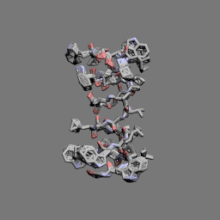Gramicidin A
 |
|
| Identifiers | |
|---|---|
| Symbol | N/A |
| TCDB | 1.D.1 |
| OPM superfamily | 69 |
| OPM protein | 1grm |
| Clinical data | |
|---|---|
| ATC code | |
| Identifiers | |
| Synonyms | Bacillus brevis gramicidin D |
| CAS Number | |
| DrugBank | |
| ChemSpider | |
| UNII | |
| KEGG | |
| ChEMBL | |
| ECHA InfoCard | 100.014.355 |
| Chemical and physical data | |
| Formula | C99H140N20O17 |
| Molar mass | 1882.3 g/mol |
|
|
|
|
|
Gramicidin is a heterogeneous mixture of three antibiotic compounds, gramicidins A, B and C, making up 80%, 6%, and 14%, respectively, all of which are obtained from the soil bacterial species Bacillus brevis and called collectively gramicidin D. Gramicidin D contains linear pentadecapeptides, that is chains made up of 15 amino acids. This is in contrast to gramicidin S, which is a cyclic peptide chain.
Gramicidin was discovered in the United States in 1939.
Gramicidin is active against Gram-positive bacteria, except for the Gram-positive bacilli, and against select Gram-negative organisms, such as Neisseria bacteria. Its therapeutic use is limited to topical application, as it induces hemolysis in lower concentrations than bacteria cell death, so it cannot be administered internally. Since the exterior epidermis is composed of dead cells, applying it to the surface of the skin will not cause harm.
It is used primarily as a topical antibiotic and is one of the three constituents of consumer antibiotic polysporin ophthalmic solution.
In 1939, the French microbiologist René Dubos isolated the substance tyrothricin and later showed it was composed of two substances, gramicidin (20%) and tyrocidine (80%). These were the first antibiotics to be manufactured commercially.
Gramicidin is a polypeptide with alternating L- and D-amino acids, sharing the general formula: formyl-L-X-Gly-L-Ala-D-Leu-L-Ala-D-Val-L-Val-D-Val-L-Trp-D-Leu-L-Y-D-Leu-L-Trp-D-Leu-L-Trp-ethanolamine
X and Y depend upon the gramicidin molecule. There exist valine and isoleucine variants of all three gramicidin species, and 'X' can be either. Y determines which is which; as Y gramicidin A contains tryptophan, B phenylalanine, and C tyrosine. Also note the alternating stereochemical configurations (in the form of D and L) of the amino acids; this is vital to the formation of the β-helix.
...
Wikipedia
